Since starting our 2023 cruising season, we have noticed that our trusty Vetus GLX65SIC diesel generator has been unable to provide more than 3000 Watts of power to our Victron Quattro Charger/Inverter. In previous seasons we have regularly been taking 5000 Watts of power out of it, meaning faster more efficient charging and consequently, less hours of operation.
We have now found and fixed the cause of the issue (more on that later) and in diagnosing the problem, have learnt a lot more about AC generators, that I will try and pass on through this article.
The generator is an important part of our Serial Hybrid system, which although we try and use as little as possible, must be reliable and efficient when we need it. If we have a couple of long cruising days or it is overcast for an extended period, we know we can run the generator for a few hours and top-up our batteries – an important security blanket.
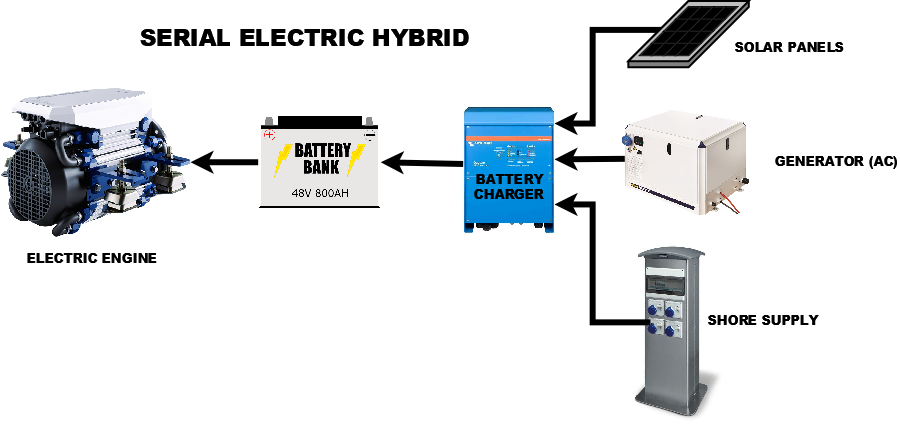
I have written about our choice of generator in a previous article (see here) but basically, it is a Vetus GLX65SIC single phase 230V AC generator that can output 6KW of power, which is used by our Victron Quattro to either charge the batteries or supply our onboard AC appliances.
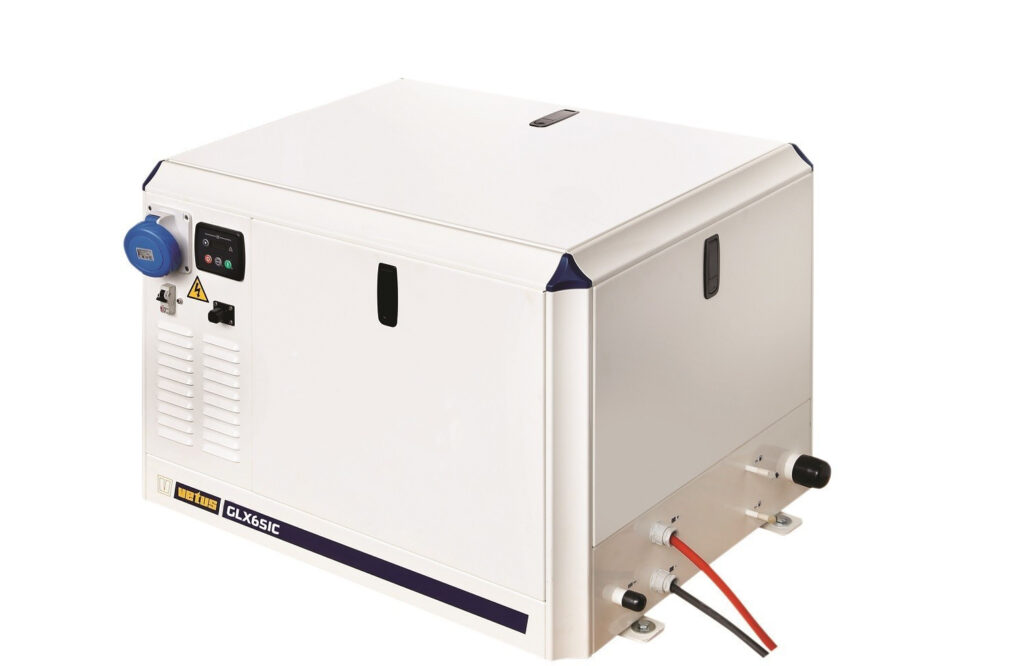
When we found that we were getting 40% less power out of the generator than in previous seasons, imaginary alarm bells went off and I immediately started an investigation. The fault symptom, was that the generator would start perfectly, run for 10 seconds and then the Victron Quattro would auto-detect that AC power was available and switch to Battery “Bulk” charging mode. As this load was suddenly applied to the GLX, you could hear the engine note change and then after a second or two the Quattro would reject the AC input and switch back to Inverter only mode, taking power from the batteries again.
On our Ortomate Boat Control and Monitoring system, we have the facility to limit the AC current that the Quattro tries to take from the generator, so I reduced the value from 23A down to 10.4A (minimum value allowed). This had the desired effect and the Victron was happy with the AC power from the GLX. I then started trying to increase the AC current value and through trial and error, found that 15A was about the maximum value I could set before the Quattro rejected the AC input.
My first thought was that something had changed in the generator and so I studied the installation and operation manual looking for any adjustments that might correct the problem. Below, is a diagram of the key component parts of a typical AC Diesel Generator.
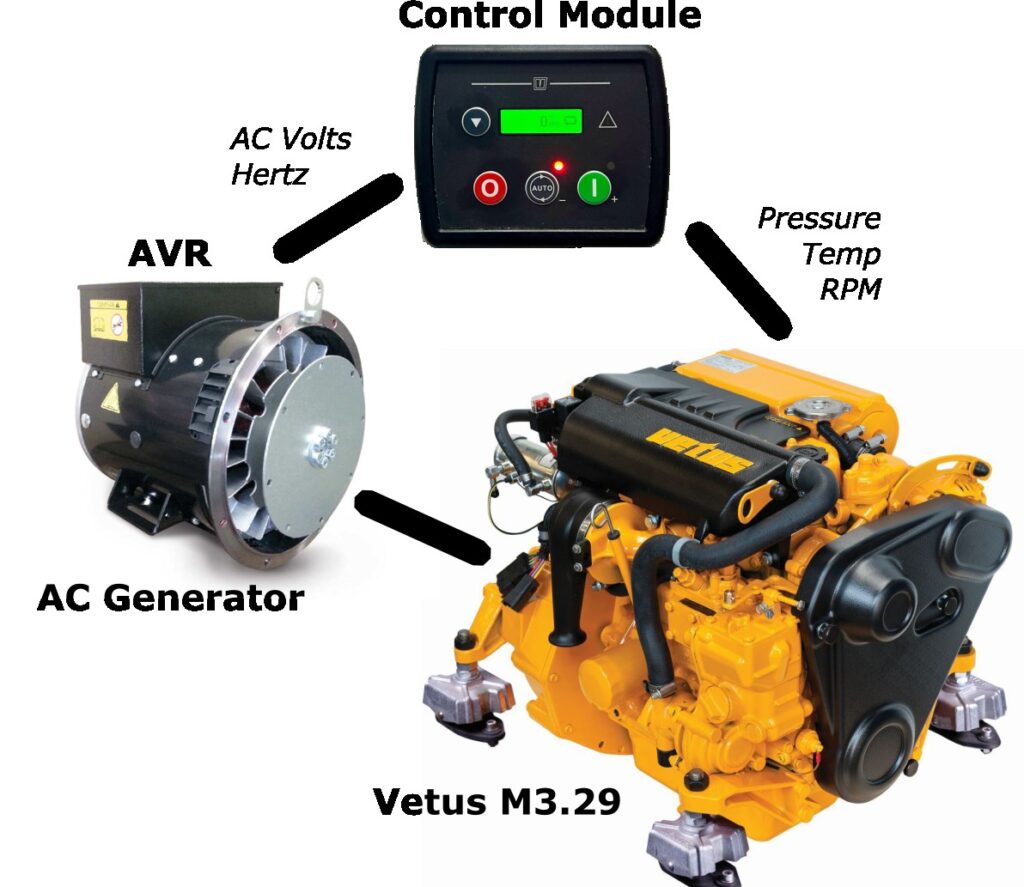
At the heart of the generator is of course the diesel engine and in the case of our GLX65SIC this is a Vetus M3.29 model. The engine is directly connected to the AC generator (no gear box) which has a four pole, brushless design. Similar to an alternator, but without the DC rectification, as the generator turns the windings inside create a 230V alternating voltage output. An Automatic Voltage Regulator (AVR) maintains the 230v output regardless of the load on the output and a mechanical throttle adjuster and fuel governor on the engine, keeps the engine at 1500 RPM, ensuring that the AC has a stable 50Hz output frequency.
The last key component, is the control module that manages the engine start cycle; pre-heat, primes the fuel, engages the starter motor, etc. and then monitors that the AC Voltage and Frequency output plus the engine’s RPM, Temperature and Pressure are all within set limits. Should any measurement be out of range, then the control module will turn off the engine.
The only adjustments that could have an effect on the generator’s ability to provide a good AC input to the Quattro, were the RPM or the fuel governor. After consulting the GLX installation manual and trying some adjustments, we saw a slight improvement (an increase to 18A) but we were still a long way off from the previous power output.
Now our attention turned to the Quattro unit and what settings affected the rejection of the AC Input. With the kind assistance of Rob Howdle at Ortomarine, we installed the Victron VE.Config application on my PC, downloaded the current Quattro’s settings using the Victron VRM, opened the downloaded settings using VE.Config and started to look at things we could adjust.
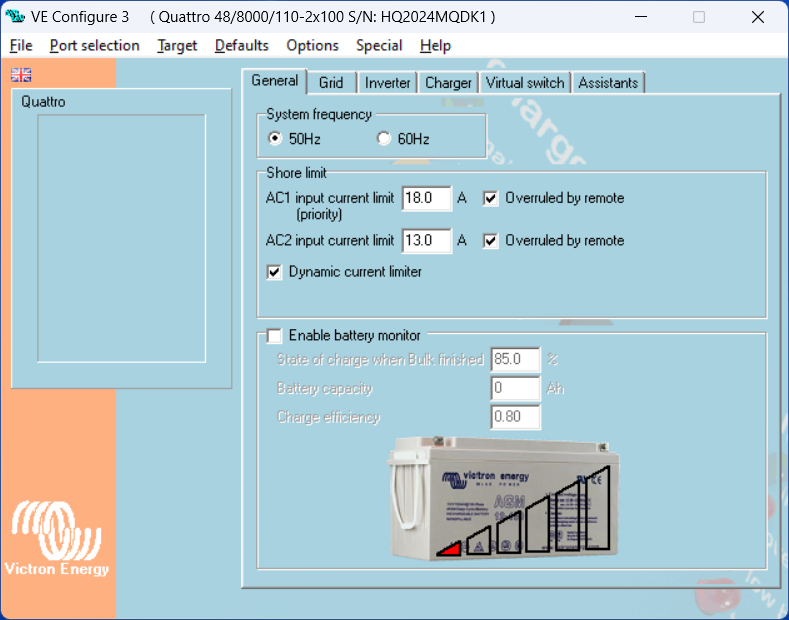
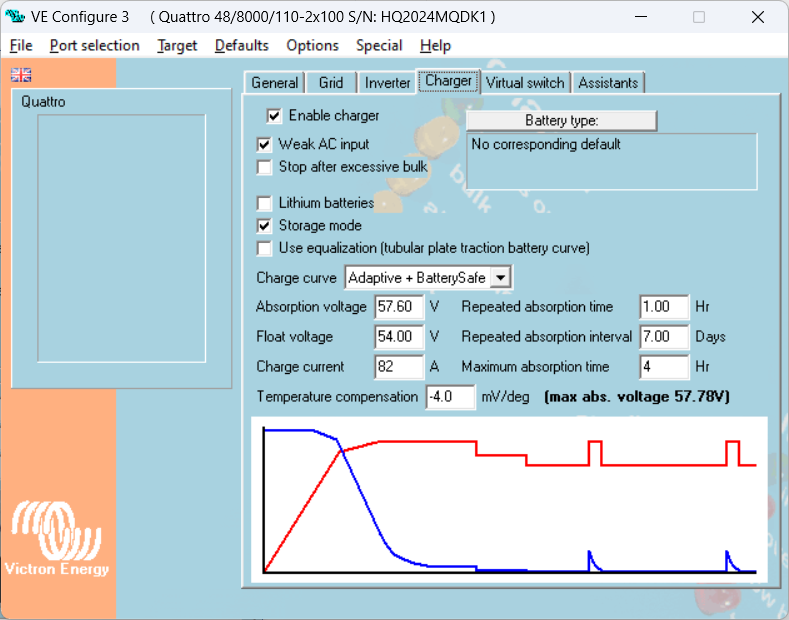
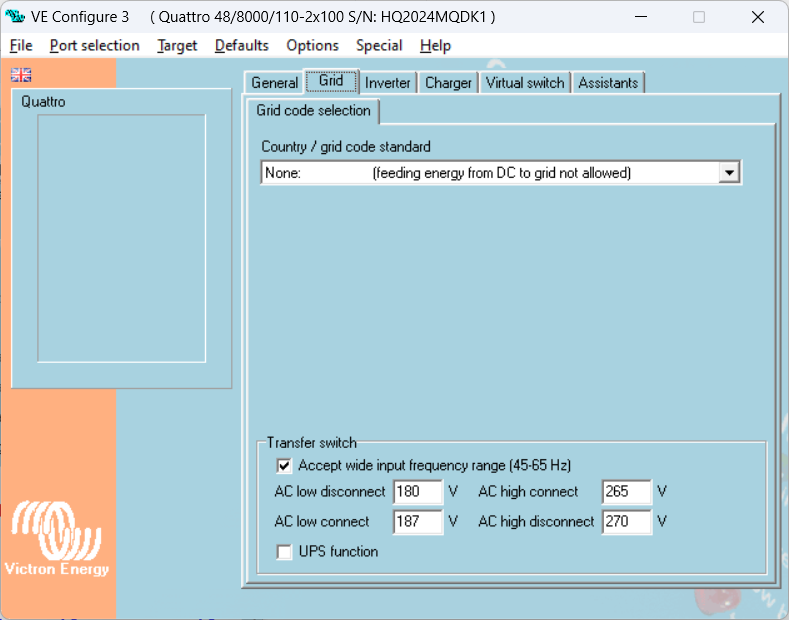
Two settings immediately jumped out at us – “Dynamic Current Limit” that would slowly apply the load to the generator and “Weak AC” that would do a less severe set of tests on the AC waveform. Enabling both of these settings did not really make any difference and so I resumed my search online and found a Victron Generator FAQ that listed the two settings that we had tried, but also listed a setting that I would never have expected to affect our setup – the UPS setting in the GRID page.
https://www.victronenergy.com/live/multiplus_faq
This setting, which was now enabled by default, would make the AC source selection much more sensitive and so I decided to give it a go and by disabling the UPS, everything worked perfectly and I could increase the AC current to 25A with no rejection – RESULT!
On further digging, it would appear that the UPS function being enabled by default, seems to have been a recent firmware update. This winter I updated all of my Victron equipment and so, unknowingly, the problem appears to have been of my own creation. Perhaps I should follow that age-old advice of “If it ain’t broke, don’t fix it” when it comes to firmware updating, but at least everything is now OK for the rest of the season – happy days.

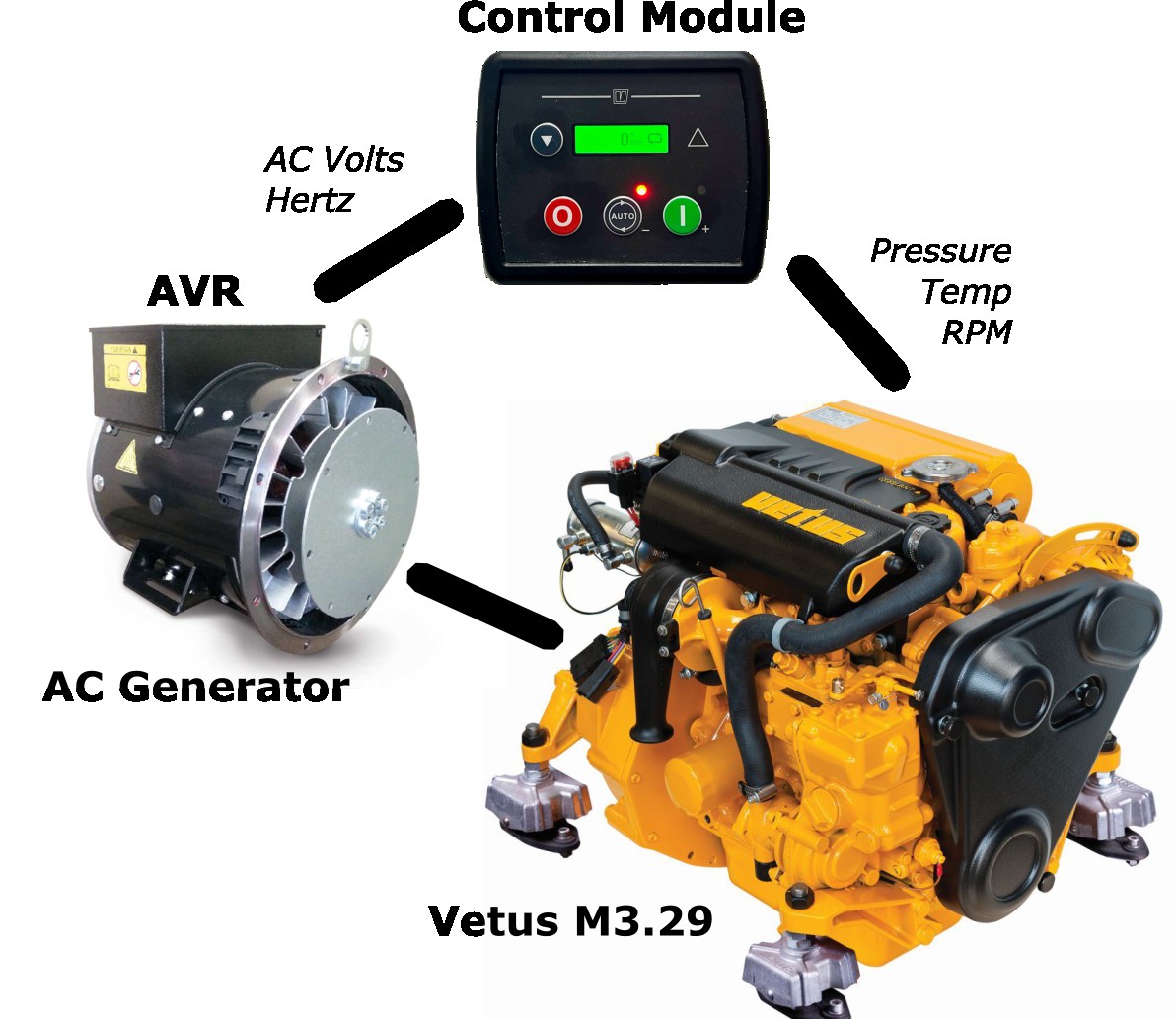
A salutary tale, Paul. I was nervous about doing software updates and now I may stick with the “if it ain’t broke” solution!
Very wise – after all caution is the better part of valour – or so they say.
Nice one Paul.
often at work we get patches to fix a fault, that then create other faults. so i feel your pain.
Thanks for the info Paul! Good to see you the other day. We have the same system and our generator has a 25A breaker. Is yours on a 25A breaker also? I’m surprised you’re taking a load so close to the breaker limit.
Hi Nice,
Yes our lock meeting was a very pleasant surprise.
You are right, I just checked and our breaker is 25A, which was a surprise considering that this model is capable of outputting 6KVA.
I have mainly had the Quattro set at 23A, just because I did not want to run it at its maximum, all of the time. I have never had an issue and the longest we have run it is probably around 4 hrs.
A breaker should not be regularly used at more than 80% of its current rating and so I think I will swap the breaker for a 30A one this winter.
Best regards
Paul
Vetus (Steve) advised that changing to a 30A would invalidate the warranty. I don’t see how it’s possible to get the advertised 28A / 6500W output from this generator!
Hi Nigel,
I have dug in to this a bit more.
The GLX6,5SIC is specified as a 6KVA generator which is not the same as 6KW. The reason being is that all generators have a Power Factor which is the difference between the apparent power and the real power going in to a reactive load. In the case of the GLX6,5SIC, its AVR has a power factor of 0.8.
This means that when it is generating 6KVA only 4800W is going in to the Quattro as real useable power, which is typically what I am seeing. So this means the AC current going through the breaker is only about 21A, only slightly higher than the safe 80% nominal current that a 25A breaker should be subjected to.
This Power Factor is often overlooked when people consider AC Generators, but it is common for all generators to have a 0.8 PF depending on the load they are supplying or in some cases even less. This article by my friend, another Ortomariner, explains it very well.
https://www.perseverancenb.com/post/generator-specification-or-smoke-and-mirrors
So I can understand why Vetus have fitted a 25A breaker and you need to base your future power calculations based on a 6KVA generator with a 0.8 Power Factor giving 4800W.
Hope this helps.
Cheers
PAUL